
- Homepage
- Brand
- Alkota (77)
- Author Doll (38)
- Bestpysanky (28)
- Buyrussiangifts (47)
- Ceprueb Nocag (21)
- Fedoskino Style (15)
- Firebird (17)
- Firebirdworkshop (33)
- Greatrussiangifts (25)
- Hand Painted (14)
- Handmade (922)
- Handmadfe (53)
- Matryoshka (48)
- Nesting Dolls (35)
- Nestingdollsstore (22)
- Russian (50)
- Russian Nesting Doll (16)
- Semenov (18)
- Sergiev Posad (34)
- Unknown (19)
- ... (4811)
- Doll Size
- Ethnicity
- Sport
- Team
- Type
- Action Figure (7)
- Art Toy (4)
- Artist Doll (5)
- Charm(s) (13)
- Doll (24)
- Dolls (4)
- Fashion (5)
- Figure (4)
- Figurine (6)
- Hand Painted (55)
- Lacquer Box (17)
- Light Sculpture (3)
- Matryoshka Dolls (3)
- Nesting (346)
- Nesting Doll (954)
- Nesting Dolls (15)
- Russian (7)
- Russian Dolls (31)
- Set (6)
- Standard (3)
- ... (4831)
Matryoshka Nesting Russian Dolls Edmund Dulac GENUINE 3 illustration FAIRY TALE













This is a beautiful and unique set of 3. Nesting dolls painted and signed by The Russian Artist Maria ROZE.
Height of the biggest doll is 14 cm or 5 1/2 inches. Edmund Dulac was born in 1882, 15 years after Arthur Rackham and a decade or more after Charles and Heath Robinson. Only Kay (rhymes with "high") Nielsen (1886) of the five major "Golden Age" gift book illustrators was younger. For comparison, that puts him in the generation of N.Wyeth, Willy Pogany and Joseph Clement Coll. He was born in Toulouse, France. His artistic bent manifested itself early and drawings exist from his early teens. Many of these early efforts are watercolors, a medium he would favor through most of his life.
He studied law at the University of Toulouse for two years while attending classes at the Ecole des Beaux Arts. As Colin White puts it in his inestimable Edmund Dulac, Two years of boredom at the law school and the winning of a prize at the Ecole des Beaux Arts convinced Dulac where his future lay. He left law school and enrolled full-time in the Ecole.
He won the 1901 and 1903 Grand Prix for his paintings submitted to the annual competitions. A scholarship took him to Paris and the Académie Julien where he stayed for three weeks.
That same year (1904) he left for London and the start of a meteoric career. It's important to understand the timing of Dulac's arrival in London. Until the mid-1890s, there had been no economical method of reproducing color plates. Printing methods in those days varied from printer to printer and were most often patented - and were always being improved. The invention of the process we now call "color separation" made it possible to mass-produce color images and by 1905 they improved the process to create images that were very faithful to the originals.The only drawback was that they had to be printed on a special coated paper and therefore couldn't be bound into the book with the rest of the pages. They had to be tipped-in. One of the earliest manifestations of this was Arthur Rackham's Rip Van Winkle in 1905. The illustrated gift-book was born just as Edmund Dulac arrived. Rackham was a grizzled veteran of ten years in the illustration business and Dulac was looking for his first assignment.
How odd that these two men would dominate the new market. Dulac's first book assignment was for the publisher J. Dent's collected works of the Bronte sisters. It's a testament to Dulac's skills that he, a 22-year-old, unpublished foreigner, was given a commission for 60 color illustrations (sample at left). It's also a reflection of the degree to which this Frenchman had been Anglicized that he was soon contributing to the Pall Mall Magazine along with Rackham and Robinson.
An interesting aspect of these early illustrations is that they don't depend on an ink line to hold the color. Rackham especially and, to a slightly lesser extent, the Robinsons tended to approach the new color medium almost as a colored ink drawing. Dulac, though capable of pen and ink work, was primarily a painter and used the new technology's ability to reproduce exact tones to let the color hold the shape and define the object. This is one of the effects of Dulac's timing.The color separation process was "perfected" just at the exact moment he arrived and he never had to deal with the old-fashioned necessity of an ink line bounding the color to hide misregistration. With the wild success of Rackham's Rip Van Winkle and his 1906 Peter Pan in Kensington Gardens, other publishers were looking for artists to produce their own gift books. Hodder and Stoughton had published Rackham's Peter Pan.
When Rackham signed with Wm Heinemann, it was Edmond Dulac, on the recommendation of Leicester Gallery, that Hodder and Stoughton turned to to illustrate The Arabian Nights for 1907 (top image above). Dulac would repeat this arrangement with the gallery for years, one book at a time.
An interesting thing happens in 1913. The mellow, romantic blues give way to a brighter palette and a more oriental style - a permanent change in his approach. 1914 saw publication of Sinbad the Sailor and Other Stories From the Arabian Knights and the start of WWI. Dulac immediately started contributing to relief effort books. His work is in King Albert's Book, Princess Mary's Gift Book and in 1915 he created his own book, Edmund Dulac's Picture Book for the French Red Cross - the only one done by a single artist. He managed to have Edmund Dulac's Fairy Book released in 1916. When the war ended, the last of his deluxe editions, Tanglewood Tales saw print. At 35, Dulac's profession was obsolete. Well, that would have been true if illustrating books was all he was capable of. He was an admirable caricaturist and for a year and a half (1919-20) he provided a drawing to each issue of the weekly newspaper, The Outlook. He illustrated The Kingdom of the Pearl, a 1920 history (see image at left). He designed costumes and sets for the theatre. He became a designer of stamps for Britain and, during WWII, Free France (plus their bank notes). He designed playing card (backs and the royalty faces), chocolate boxes, medals, graphics for The Mercury Theatre, bookplates and more. American WeeklyIn 1924, he began an association with The American Weekly, a Sunday supplement for the Hearst newspaper chain, whereby he would create a series of cover paintings around an agreed-upon theme. The first series, Bible Scenes and Heroes started in October of 1924 and ran for twelve installments. He would return again and again to this market as his primary source of income until 1949.The image below is from a Fall, 1942 series on The Canterbury Tales. Dulac was never happy with the reproduction methods and the quality (or lack thereof) in the finished product. At right is an unretouched excerpt from the greatly rejuvenated image below.
The cheap pulp paper and the fold across the artwork did little to satisfy his perfectionist tendencies. Still, it continued to pay the bills. Of all the great gift book illustrators, Dulac remained the most active throughout his life. They weren't as ornate or as frequent, but The Green Lacquer Pavilion (1925), Treasure Island (1927), A Fairy Garland (1928), The Daughters of the Stars (1939), The Golden Cockerel (1950), The Marriage of Cupid and Psyche (1951) and Comus (1954) far surpassed the output of any of his contemporaries. The last three on that list were published as deluxe signed editions by The Limited Editions Club and the last was published posthumously.We speak French, English, German and Russian. Please leave feedback once you have received the item so that I know it has arrived safely.
I will leave feedback in return. Smoke & Pet Free Item.

